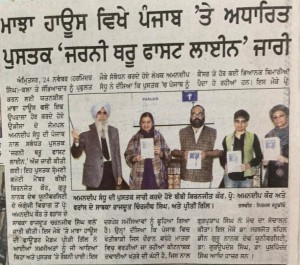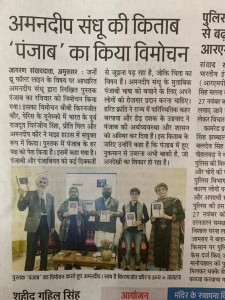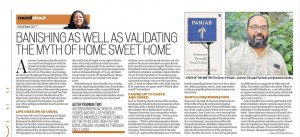Dear Friends,
reader and dear friend Maithreyi Karnoor whose novel in translation A Handful of Sesame has just won the prestigious Kuvempu Bhasha Bharathi Pradhikara book prize was inspired to write the following account of her visit to Panjab while reading Panjab: Journeys Through Fault Lines.
I share the Facebook link here and post below too.
Panjab, Journeys Through Fault Lines is a work of narrative non-fiction by Amandeep Sandhu. I’m not qualified to review this book. Neither am I from Punjab nor am I a student of Punjab Studies to have an informed say on this book. My only connection to Punjab is the fact that it happens to be one of the states that form the federal union that my state is a part of. That, and the high probability that the wheat for my lunch chapatti comes from Panjab.
I think a well-told story deserves other stories in response. It is one, and this is mine.
When I was little, I pestered my mother for stories. I would point at pictures—a caricature in a magazine, a photograph in a newspaper, an advertisement hoarding in the bus stand, a book cover—and ask her to tell me its story. I believed that every picture is there to tell a story. And my mother would turn into an ekphrastic artist on the spur on the moment. Since then, I only read books that have stories to tell.
The simple and elegant blue and white cover of this book features a directional billboard with a broken arrow pointing towards ‘Panjab’. I want to know why the name of the state is not spelt the official way (as Punjab). I understand that the shattered arrow indicates the fault lines the title speaks of. I want to know what these fault lines are.
I have only been to Punjab once. The organisation I worked for a year ago invited me to attend a seminar in Chandigarh. People presented papers and drank cups of tea (the coffee sucked). My colleagues and I did as much of the tourist circuit as we could in the two days we were left with after that: the golden temple, Jallianwalla Bagh and the Wagah border. I was moved to tears at the partition museum and walked on alone while some of my colleagues busied themselves with selfies. Hordes of tourists chattered on endlessly at Jallianwallah Bagh – a place that demanded poignant silence. I was sickened to the stomach by the riotous show of jingoism—complete with Bollywood music—at the Wagah border. I gave up every pretence of camaraderie when one of my colleagues—an employee of the woke organisation that is known to make tangible differences in the field of education in India—began cheering a burqa-clad woman made to carry the Indian flag. This person gave me a dirty look when I did not clap along. At the Golden temple that evening, I was awestruck by the sheer scale of the number of people fed for free and the massiveness of the place run like clockwork completely on volunteer work. I craved solitude and excused myself from entering the sanctum sanctorum by faking a period. I am certain the Sikh religion can’t care less about deeming natural body processes impure, but I was also certain that my fellow tourists would not argue against it. I sat alone, my head covered for piety, drinking in the sight of the dazzling dome lit by night lights and the colourful catfish frolicking in the sarovar waters close to where I sat. I shed a few silent tears for what the sight beheld – a place of beauty and grace, faith and service, but one whose history was awash in blood.
My colleagues came back complaining about being too late for the famed kada prashad. We boarded our rented SUV and headed back to Chandigarh. The driver played loud Punjabi pop music and as I covered my ears, I wondered about the contrary nature of my brief experience with Punjab.
On the way, we passed several vehicles carrying people dressed in Ramaleela costumes. The same colleague whose chest had swollen with pride at the sight of a Muslim woman’s patriotism for India made a derisive comment about the garishness of ‘north Indians’.
The next morning, we saw on the news that a train had ploughed into a Ramleela gathering near Amritsar killing hundreds of people.
My very brief brush with Punjab left me both shattered and fascinated. I wanted to know its story.
Then I read Panjab: Journeys Through Fault Lines.
I understood that the author had used the spelling Panjab to point at its etymology: as Panj+Aab it started off as the land of five rivers. After partition, it is no longer that. In that, it mimics India’s nomenclature where the eponymous river, Indus, is no longer a part of its geography. Punjab, the site of the green revolution, where the land was coaxed and coddled into yielding more agricultural produce than it naturally could has lost much of its water and its water table continues to plunge deeper. That’s the irony of its name. I knew this is the story I wanted to hear.
Each chapter in the book marks a fault line.
1. Satt – Wound
2. Berukhi – Apathy
3. Rosh – Anger
4. Rog – Illness
5. Astha – Faith
6. Mardangi – Masculinity
7. Dawa – Medicine
8. Paani – Water
9. Zameen – Land
10. Karza – Loan
11. Jaat – Caste
12. Patit – Apostate
13. Bardr – Border
14. Sikhya – Education
15. Lashaan – Corpses
16. Janamdin – Birthday
This is the exhaustive list of discourses through which ills plague Punjab according to the author, and he engages with the widely researched issue of each chapter through a personal narrative that infuses in it a poetic depth that dry data is infinitely incapable of. The constructive epistemology of this categorization is the key one must concentrate on in grasping its essence. The author’s mother suffered from cancer and cardiomegaly, and this book, a result of his endeavour to know Punjab, the land of his ancestors (he was raised in Orissa), compares the State to his mother’s body – as a land with a big heart but also one racked by many ills.
Through the warp and weft of fact and family, Panjab weaves a story that is at once deeply personal and widely instructive. While the book has much to say to a Punjabi anywhere in the world, it is precisely because of the nature of its narrative that I recommend it to readers who have nothing to do with Punjab – such as myself.







